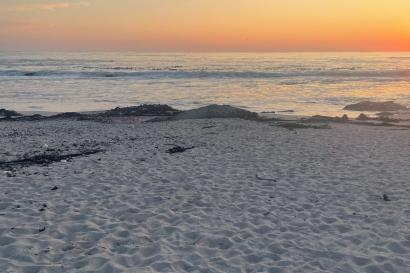
This past weekend, IES Abroad organized an optional weekend trip to Huangshan for both my Summer Internship program and the IES Abroad Summer Engineering program. My program had our last day of back-to-back Chinese classes on Thursday and departed from our apartments early Friday morning to make the six-hour drive to Anhui. Most of us were tired from having class all week and slept for the majority of the bus ride. When we finally arrived in Anhui, we headed to Hongcun, a village in the historical region of the Anhui Province, near Mount Huangshan. Hongcun is a UNESCO World Heritage Site and reminded me of some of the other water-towns I visited during my semester, but with a slightly different flare surrounding the architecture and vibe of the narrow streets. We explored for an hour, peeking into trinket shops and admiring the beautiful Moon Pond, 月沼 (yuè zhǎo). The Moon Pond, located in the middle of Hongcun, is a central identifier of this ancient village and got its name from its crescent shape. After walking around, taking pictures, and finding some yummy sweets, we boarded the bus to head to dinner and check into our hotel. We ate until we were stuffed and by the time we had finished dinner and arrived at the hotel, everyone was exhausted and ready to jump into bed. We paired up with roommates, grabbed our room keys, and headed down our respective rooms to get some rest before Saturday’s big hike!
After a delicious breakfast, we all hopped back on the bus and got comfortable for our bus ride to Mount Huangshan. Huangshan (黄山, Huángshān, Yellow Mountain) is a mountain range in the Southern Anhui province of Eastern China. Known for its beautiful mountainous scenery, classic to traditional Chinese paintings and literature, Huangshan is one of the top tourist destinations in China. Arguably ranked as the second best scenic city in China, Huangshan is also recognized as a UNESCO World Heritage Site. We drove from our hotel to the bottom of the mountain and then took another bus halfway up the mountain to where the cable cars departed from. From halfway up, it would take around three hours to hike up to the top or about twelve minutes to take the cable car… needless to say, we all filed into cable cars and enjoyed the scenic views below us as we were hoisted to the top by the strength of cable car machinery. Once we arrived at the top, we began our hike. Similar to my hiking experience at Huashan, another famous mountain in China, when we say we “hiked,” we really mean that we climbed hundreds of stairs, traveling from peak to peak. Although the mountainous views were mostly covered with thick rain clouds, the experience itself was still one for the books, chalk full of memorable moments!
Sunday’s plan was to head to the Nine Dragon Waterfall and Tunxi Old Street before making the six-hour trek back to Shanghai. After another tasty breakfast, we, once again, boarded the bus and drove to the base of the Nine Dragon Waterfall. After our Mount Huangshan hike, our legs were already tired and sore, but when told that we were going to hike to the top of the waterfall, we accepted the challenge and started on our way. When we got to the bottom of the large waterfall, we were misted with little water droplets, which sprayed off the powerful streams of water cascading down the large rock cliffs. We, of course, posed for hundreds of photos while we let our legs rest for a little before hiking up to the top of the waterfall. The stairs were carved into the side of the rock so they were just as steep as the waterfall itself. The stairs felt like they were on a 75-degree incline, but that didn’t stop us. As we huffed and puffed, we finally reached the top and it was definitely worth it! The cool breeze from the waterfall felt wonderful against our bodies after working up quite a sweat on the way up. After sitting in our Chinese classroom for almost seven hours a day, four days a week, for two weeks, you could say that we were all happy to be breaking a sweat outside, in nature, for a change. It was a much-needed break and a great way to clear our minds before starting our internships on Monday.
Before departing on the six-hour drive back to Shanghai, we stopped at Tunxi Old Street. Tunxi Old Street is said to be around 900 years old and 900 meters long. We were given free time to walk around the streets, explore on our own, grab a bite to eat, and shop. My friends and I found lots of little snacks, ink slabs, jewelry, and toyshops as we wondered. Tunxi attracted many tourists and reminded me of the strips of shops and vendors that adorned the canal streets in Xitang, Wuzhen, and other water-towns. We all bought a few souvenirs for friends and family before boarding our bus, ONE LAST TIME!
Although the weather wasn’t great and it rained for a majority of the weekend, it was still wonderful to get outside of the city, to explore a new and beautiful scenic area, to breathe fresh air, and to get to spend more time with the students on my program without the stress of Chinese class and homework. I’m glad that I was able to get some exercise and bond with the kids on my program before parting our separate ways with our individual internship assignments and being cooped up in an office from 9:00am-6:00pm during the weekdays. So, if you ever find yourself in the Anhui province, I would highly suggest visiting the areas that we spent time in!

Lexi Kelley
<p>Ever since I was a child, my life has always been linked to helping other people. I founded Kids Helping Kids when I was in sixth grade after I was in a serious car accident. While in the hospital, I heavily relied on the support of my friends and family as I had recovered. As I reflected on my accident and the serious injuries I had suffered, I saw the incredible power that I was shown as everyone came together to help me heal. The idea to start KHK was inspired by the small acts of kindness I witnessed from so many. I was so moved by the generosity of my peers that I wanted to harness that energy and share it with others, who may not have the same access to support. Kids Helping Kids has changed the way I view the world and others around me. I love volunteering because of the experiences and lessons I gain. It has shown me the power I have to make a difference in another person's life, and the impact that the people we serve have on my life.</p>









